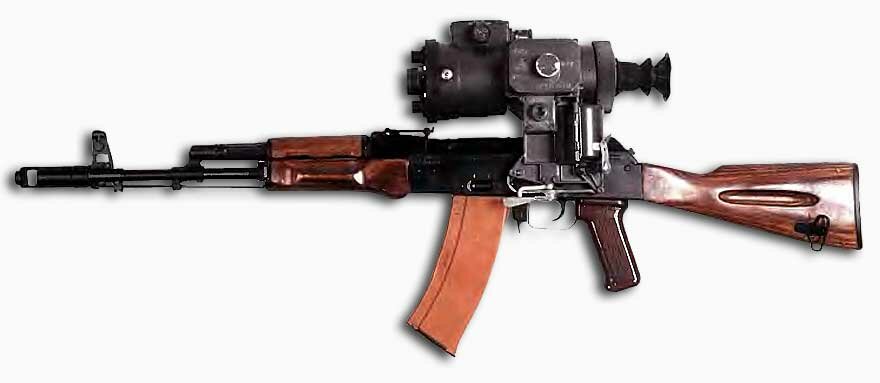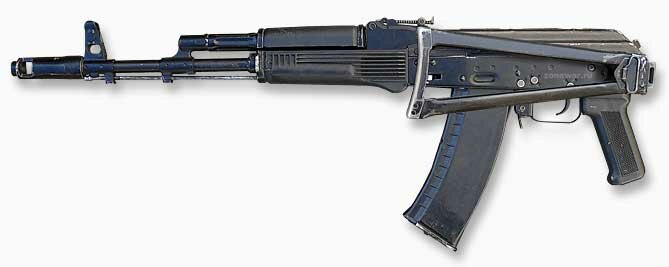5.45 mm Kalashnikov АК 74 assault rifle mod. 1974

AK-74 model 1976 with the wooden forearm and butt

AK-74 model 1989, the forearm and the butt of plastic
Studies made in 1955-1965 allowed Soviet experts to make the conclusion that the most effective means of improving accuracy of fire is to reduce shot recoil impulse. In 1964 draft operational requirements for a small-calibre assault rifle were issued. The work got a powerful boost after the news about the US armed forces adopting a 5.56 mm assault rifle. Already in the 1930s the prominent Russian gunmaker V. G. Fedorov found the principle of calibre reduction with transition to new types of individual weapons. Results obtained on the USA gave rise to research and development activities in other countries, including the USSR regarding weapons firing small-calibre Sow-recoil cartridges.
In 1966 the Main Missile and Artillery Directorate (Russian abbreviation — GRAU) issued requirements specification for the development of a new 5.60 mm assault rifle. The number denotes calibre of a low-recoil cartridge measured by rifling bottoms, but since calibres in Russia are measured from "land-to-land" this calibre corresponds to 5.45 mm. The 5.45 mm round for assault rifle was designed at TSNISTOCHMASH (Central Research institute of Precise Mechanical Engineering, Klimovsk) by V. M. Sabelnikov's group including L. I. Bulavskaya, B. V. Semin, M. Ye. Fedorov, P. F. Sazonov, and others. Calibre reduction from 7.62 mm to 5.45 mm led to more than 1.5-fold decrease in cartridge weight. This resulted in much greater muzzle velocity of bullet, more flat trajectory, increased point-blank range (by about 100 m), shorter time to target smaller wind age and recoil impulse: ail these factors helped to improve accuracy of fire, especially in the full-automatic mode. In fact, this solution allowed enhancing not only accuracy of fire, but overall combat effectiveness of the cartridge/weapon system as well. The elongated bullet had combined effect of stability on the trajectory and lethality (wounding) at a level not worse than the M1943 cartridge bullet.
A number of individual designers and design teams from Izhevsk Machine-building Plant (Izhmash).TSNIITOCHMASH Central Research Institute of Precise Mechanical Engineering and Kovrov Mechanical Plant took part in the contest for a new assault rifle. The Izhmash designers worked on several versions of small-calibre assault rifle. M. T. Kafiashnikov and A. D. Kryakushin developed it on the basis of the 7.62 mm AKM assault rifle, which was then in production (A3 assault rifle prototype).
Only two from ten 5.45 mm prototypes submitted to the lest competition were selected for final operational trials, namely the Kovrov SA-006 assault rifle with the "balanced gas-operated mechanism'5 designed by A. S. Konstantinov and Izhevsk A-3 assault rifle with "classical" mechanism. Detailed and exacting trials showed that the Konstantinov's prototype had higher fire effectiveness, whereas Kalashnikov's assault rifle had better operational/maintenance and production cost parameters.
In accordance with Resolution of the Central Committee of the Communist Party of the Soviet Union (CPSU) and the Council of Ministers of the Union of Soviet Socialist Republics (USSR) No. 54-29 of 18 January 1974, followed by the order of the USSR Minister of Defence of 18 March 1974P a new standardized 5.45 mm small arms system was adopted for service. The system included four basic models of the 5.45 mm assault rifle (AK 74, AKS 74, AK 74N. AKS 74N) and four 5.45 mm machine guns (RPK 74, RPKS 74, RPK 74N, RPKS 74N). In the era of "arms race3' it was important enough to be able to quickly set up line production of new-family weapons and streamline activities for their mastering and operation by armed forces.

Field-stripped АК 74 assault rifle: 1 — barrel with receiver featuring firing mechanism, sights, stock, and pistol grip; 2 — muzzle brake/compensator/flash suppressor; 3 — receiver cover; 4 — bolt carrier with gas piston; 5 — bolt; 6 — return mechanism; 7 — gas tube with handguard; 8 — forearm; 9 — magazine; 10 — cleaning rod.
The AK 74 Kalashnikov assault rifle (mod. 1974, index 6P20) basic design is identical to that of the AKM assault rifle, with which the AK 74 has common 9 assembly units (36%) and 52 parts (53%). Technological operations for the AK 74 were unified with the AKM assault rifle at about 70% level of their total number. In 1975 the AKM output was terminated, and mass production of 5.45 mm assault rifles was started in new manufacturing areas with renewed technological cycles. A greater number of the assault rifle parts (gas chamber, forearm ring, trigger, rear-sight bed, front-sight base) were made from precision castings on consumable patterns. The barrels were manufactured by radial forging with simultaneous shaping of the barrel bore and breech chamber (the technology already mastered on the 7.62mm AKM barrels with the use of Austrian-made equipment), and the barrel bores were chrome-lined by using an improved (high-speed) technology. An automated computer-aided accuracy testing method was developed and implemented.
The weapon has a gas-operated action with a long-stroke piston. The breech is locked by a rotating boil when its two locking lugs enter into the corresponding slots of the receiver.
The assault rifle design was substantially renovated by adding a two-chamber muzzle device functioning as muzzle brake, compensator, and flash suppressor.
When shot is fired, powder gases enter the gas chamber and push the gas piston together with the bolt carrier rearwards. The bolt earner travels back until gas pressure in the barrel bore drops, then the chamfer on the carrier inner surface presses with its facet against the bolt lug and turns the bolt. As the bolt opens, the chambered case is briefly dislocated (unseated). This reduces cohesion between the cartridge case and breech walls, thus preventing case rupture during subsequent extraction.
After disengaging from the receiver, the bolt pulls out an empty case with the spring extractor and moves back together with the bolt carrier: at this time the recoil spring is compressed and the hammer cocked. The used cartridge case strikes against hard ejector on the receiver and is ejected through the receiver slot on the right side. At the rearmost point, the boll earner with the bolt goes forward under the impulse of the recoil sprang; the bolt picks up another round from the magazine and chambers el. Such factors as more massive boil earner with light-weight bolt, ample clearances between moving parts within the receiver and transfer of the carrier's man weight beyond the receiver provide system's operability even in extremely dusty conditions Firing mechanism us of hammer type, with pivoting hammer and U-shaped twisted trigger spring.
The triggering mechanism enables full-automatic (bursts) and semi-automatic (single-shot) firing. A single component functions both as a fire mode selector and a manual safety lock. In the "safe" position, it blocks the trigger, semi-automatic and full-automatic sears, and prevents the bolt earner from moving rearward by partially blocking the longitudinal slot between the receiver and its cover it also protects the receiver from dirt getting inside. All parts of the gas-operated mechanism and the firing mechanism are housed in the receiver.
The bolt is made smaller than that in the AKM, its cup has no annular depression, and the firing pin protrudes above the bolt face. The extractor socket in the bolt has the form of open slot- The gas tube with the handguard ends with a spring washer at the rear end eliminating its wobbling and thrust on the gas chamber.
The assault rifle is equipped with a traditional ramp-type sight.
The 5.45 mm cartridge with lower recoil impulse (0.49 kgf) than that of the M1943 cartridge (0.78 kgf), and the muzzle brake/compensator provided improved accuracy of fire from unsteady positions. Bullet wind age dropped by half, allowing application of smaller wind corrections for the same ranges Most effective fire range increased from 400 to 500 m.
According to expert estimates, the AK 74 assault rifle is 1.2 to 1.6 times more effective than the AKM. The main firing mode for the assault rifle is full automatic, preferably short bursts (up to 5 shots per burst).
The magazine is a sector-shaped box with a plastic case and a staggered arrangement of rounds. Special tool is provided for loading the magazine from clip.
The AK 74 assault rifles in the first production batches were fitted with plastic pistol grips and wooden stocks, forearms and hand guards. Later on, the stock, forearm.., and hand guard were made of cast plastic. Eventually the main material used for manufacture of plastic components, including magazine case, became black-color glass-nylon composite.
Besides the 6Kh4 legacy knife bayonet, the new 6Kh5 knife bayonet for assault rifles with differently shaped reinforced blade and more convenient grip was adopted.
5.45 mm Kalashnikov АК 74N assault rifle mod. 1974

АК 74N assault rifle mod.1974
Modifications of the AK 74N assault rifle (№1. №2, №3) are adapted for night sights thanks to the mounting rail available on the left outer wail of the receiver.
The AK 74N1 modification (index 6P20N1) uses the NSPU universal small arms night sight, and the AK 74N2 (6P20N2) — the NSPUM sight.
The AK 74N3 modification (index 6P20N3) mounts the NSPU-3 (1PN51) universal small arms night sight. The sight ensures reliable detection of lave target at a range of up to 300-600 m depending on the level of le rain illumination with the starlight or moonlight.
The AK 74 and AKM assault rifles served as a baseline for the development of a wide family of the Saiga self-loading hunting carbines of various calibres. Copies and of the AK 74 series assault rifles were produced in various countries, such as Bulgaria. East Germany, Yugoslavia.
5.45 mm Kalashnikov AKS 74 assault rifle mod.1974 with folding stock

AKS 74 assault rifles with an unfolded stock
The АКS 74 modification (index 6P21) was adopted into service together with the AK 74 and was intended mostly for airborne assault forces.
Тhе rifle is fitted with a lightweight triangular metal butt stock folding to the left and fixed with the lug on the left-hand side of the receiver. The triangular shape of the stock made of two rods and shoulder rest, gives it required rigidity. The folded stock does not hamper firing.
Technological and engineering changes were introduced simultaneously so the AK 74 and AKS 74 designs. In particular both versions were provided at the same time with black-colour glass-nylon composite pistol gaps, forearms, hand guards and magazine bodies.
Since barrel have the same lengths ballistic characteristics of the AKS 74 assault ate identical to those of the AK 74 the AKS 74 has the same rate of fire and uses the same magazines as the AK 74.
The AKS 74 assault nfie was the first weapon of the 5.45 mm family displayed publicly as the malady parade on 7th November 1974 the new assault rifles were calmed by paratrooper guards marching on the Red Square.
The AKS 74 modifications with the mounting rail on the left side of the receiver for night sights correspond to the AK 74N modifications
— AKS 74N1 (6P21N1) with the NSPU right sight;
— AKS 74N2 (6P21N1) with the NSPUM right sight;
— AKS 74N3 (6P21N3) with the NSPU-3 right sight.

AKS-74 Kalashnikov assault rifles with a folded stock
| Specifications AK 74 AKS 74 Caliber......................................................................................5.45................................5.45 Cartridge...........................................................5.45x39 (Mod. 1974).........5.45x39 (Mod. 1974) Weapon weight w/o cartridges, kg..........................................3,07.................................2,97 Length w/o bayonet, mm.........................................................940..................................940 Length w/folded stock, mm.......................................................—...................................700 Barrel length, mm.....................................................................415 .................................415 Bullet muzzle velocity, m/sec....................................................900..................................900 Rate of fire, rds/min.................................................................600..................................600 Effective rate of fire, rds/min...............................................40/100.............................40/100 Sighting range, m...................................................................1000................................1000 Magazine capacity, rds................................................................30...................................30 |
||

